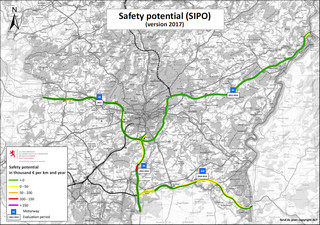EU-Directive 2008/96/CE - road infrastructure safety management
In application to the EU Directive « 2008/96/CE » and the law from the 27th of April 2012 concerning “la gestion de la sécurité des infrastructures routières”, the National Road Administration is obliged to inform the road users about road sections on the Trans European Transport Network (TEN-T) with a high accident cluster. The safety potentials (SIPO) of single road sections are established for this purpose. Since 2019 the safety potentials are published by the National Road Administration not only for the Trans European Network TEN-T, but for the entire Luxembourgish motorway network.
TEN-T (Trans European Transport Network): European highway network which underlies the directives of the European Commission. The TEN-T includes the following highways in Luxembourg:
- A1 (Croix de Gasperich – border crossing point Wasserbillig)
- A3 (Croix de Gasperich – border crossing point Zoufftgen)
- A6 (Croix de Gasperich – border crossing point Weyler)
- A13 (Croix de Bettembourg– border crossing point Schengen)
SIPO (safety potential): The safety potential of a road section is the difference between the expected accident costs (quantity and severity of the accidents) at a road infrastructure corresponding to the standards, and the real accident costs.
Thereby, the safety potential is an important parameter showing the identification of road sections, for which safety improving measures are expected to have the biggest effect. The safety potential does not describe the absolute number of accidents, but it is calculated from the determined accident costs according to the “Recommendations for security analysis of road networks” by the German Road and Transportation Research Association (FGSV).






